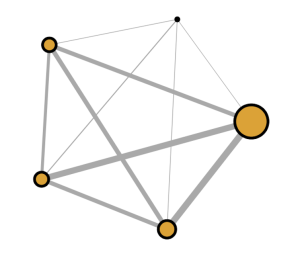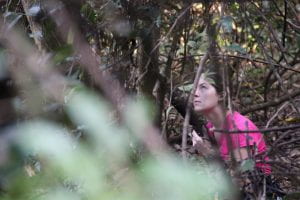My research focuses on the role communication plays in the structure and function of social groups (both non-human and human) and also how the dynamics of these groups and their broader environment affect communication patterns. I study this topic with the aid of remote technology that enables the collection of detailed data on the communication (and other) behaviors of many group members simultaneously in combination with computational methods for data analysis and modeling.
Some of my past studies have focused on the role contact calls play in the coordination of group-wide movement behavior in goats and baboons, the role food-associated calls play in the social foraging behavior of chimpanzees, and the role vocal turn-taking plays in the emergence of collective intelligence in human teams.
Through my work, I aim to expand knowledge of the mechanism, function, and evolution of communication systems. I also aim to apply this knowledge towards the design of solutions to important social challenges in our own societies (e.g., improving collective intelligence, design of distributed artificial systems) and towards the conservation and management of other species.
Contact Calls and Collective Movement
I was awarded a Postdoctoral Fellowship in Studying Complex Systems from the James S. McDonnell Foundation based on my proposal to integrate active communication signals into studies of collective animal behavior. I developed and built in-house wearable dataloggers that contain not only GPS and accelerometers, but also audio recorders. These tools were some of the first of their kind and enabled me to obtain detailed, continuous data on the communication, social and non-social behaviors of many group members simultaneously. I used these tools to collect data on free-ranging goats, sheep and wild baboons at Tsaobis Nature Park in Namibia with focus on understanding the role vocal signals play in the coordination of group-wide behavior. This work was featured in an article in Nature Magazine.
Related Publications
Papadopoulou1 M, Fürtbauer I, O’Bryan LR, Garnier S, Georgopoulou D, Bracken AM, Christensen C, King AJ. (2023) Dynamics of Collective Motion Across Time and Species. Philosophical Transactions of the Royal Society B, 378(1874)
Sankey D, O’Bryan LR, Garnier S, Cowlishaw G, Hopkins P, Holton M, Fürtbauer I, King AJ. (2021) Consensus of travel direction achieved by simple copying, not voting, in free-ranging goats. Royal Society Open Science, 8(2), 201128
O’Bryan LR, Abaid N, Nakayama S, Dey T, King AJ, Cowlishaw G, Rubenstein D, Garnier S. (2019) Contact Calls Facilitate Group Contraction in Free-Ranging Goats (Capra aegagrus hircus). Frontiers in Ecology and Evolution, 7, 73
Vocal Turn-taking and the Emergence of Collective Intelligence in Human Teams
I think broadly about the role communication plays in collective intelligence, decision-making, and coordination across social groups. Some of my current work focuses on these topics within the realm of human social behavior.
This work focuses not on what is being communicated, but rather on patterns of communication, such as the timing and directedness of speaking turns. I aim to connect these patterns to well-studied constructs in team studies (e.g., team member effectiveness, leadership, influence) and relate them to team outcomes. Through inspiration from studies of animal swarm intelligence, I am developing new ways of linking individual traits, behavioral processes, and group outcomes. In addition, I intend to bring knowledge back to the field of animal behavior to inspire new approaches.
such as the timing and directedness of speaking turns. I aim to connect these patterns to well-studied constructs in team studies (e.g., team member effectiveness, leadership, influence) and relate them to team outcomes. Through inspiration from studies of animal swarm intelligence, I am developing new ways of linking individual traits, behavioral processes, and group outcomes. In addition, I intend to bring knowledge back to the field of animal behavior to inspire new approaches.
Related Publications
O’Bryan LR, Oxendahl T, Garnier, S, Segarra S, Wettergreen W, Sabharwal A, Beier ME. (2023) Idea quality, influence, and the emergence of collective intelligence in teams. Manuscript submitted for publication
Oxendahl T, O’Bryan LR, Beier M. (2023) Psychological and Behavioral Predictors of Peer Perceptions of Team Member Effectiveness: A Field Study of Virtual Team Meetings. Manuscript submitted for publication
O’Bryan LR, Oxendhal T, Chen X, McDuff D, Segarra S, Wettergreen M, Beier ME, Sabharwal A. (2022) Objective Communication Patterns Associated with Team Member Effectiveness in Real-world Virtual Teams. Human Factors, 0(0)
O’Bryan LR, Segarra S, Paoletti J, Zajac, S, Beier M, Sabharwal A, Wettergreen M, Salas E. (2022) Conversational Turn-taking as a Stochastic Process on Networks. 56th Asilomar Conference on Signals, Systems, and Computers, Pacific Grove, CA, USA, pp. 1243-1247
O’Bryan LR, Beier, M, Salas, E (2020) How approaches to animal swarm intelligence can improve the study of collective intelligence in human teams. Journal of Intelligence, 8, 1
Food-associated Calls and Social Foraging
While most work on food-associated calling behavior has focused on its potential to function referentially for receivers, my dissertation research centered on its function from the signaler’s
 perspective. I investigated 1) how chimpanzees make food patch residence decisions, 2) tradeoffs between foraging and socialization, and 3) the impact food-associated calls have on the behavior of other foragers. I conducted foraging and playback experiments with captive chimpanzees at the National Center for Chimpanzee Care at the Michale E. Keeling Center for Comparative Medicine and Research in Bastrop, Texas and observations of wild chimpanzees at the Gombe Stream Research Centre in Gombe National Park, Tanzania.
perspective. I investigated 1) how chimpanzees make food patch residence decisions, 2) tradeoffs between foraging and socialization, and 3) the impact food-associated calls have on the behavior of other foragers. I conducted foraging and playback experiments with captive chimpanzees at the National Center for Chimpanzee Care at the Michale E. Keeling Center for Comparative Medicine and Research in Bastrop, Texas and observations of wild chimpanzees at the Gombe Stream Research Centre in Gombe National Park, Tanzania.
Related Publications
O’Bryan LR, Schapiro S, Lambeth S, Wilson ML. (2021) Playbacks of Food-associated Calls Attract Chimpanzees to Known Food Sources in a Captive Setting. Primates, (62), 905-918
O’Bryan LR, Lambeth SP, Shapiro SJ, Wilson ML (2020) Unpacking Chimpanzee (Pan troglodytes) Patch Use: Do Individuals Respond to Food Patches as Predicted by the Marginal Value Theorem? American Journal of Primatology, e23208